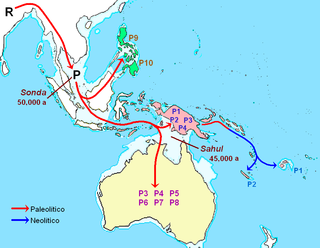Distribution
| | This section is empty. You can help by adding to it. (December 2009) |
| Haplogroup R2'JT | |
|---|---|
| Possible time of origin | 42,600 to 67,100 YBP |
| Possible place of origin | Probably south asia or Southwest Asia |
| Ancestor | R |
| Descendants | R2, JT |
| Defining mutations | 4216 |
Haplogroup pre-JT is a human mitochondrial DNA haplogroup (mtDNA). It is also called R2'JT.
Haplogroup pre-JT is a descendant of the haplogroup R. It is characterised by genetic marker at 4216. The pre-JT clade has two direct descendant lineages, haplogroup JT and haplogroup R2.[ citation needed ]
| | This section is empty. You can help by adding to it. (December 2009) |
Its subclade is Haplogroup JT, which further divides into Haplogroup J and Haplogroup T.
| | This section is empty. You can help by adding to it. (December 2009) |
Phylogenetic tree of human mitochondrial DNA (mtDNA) haplogroups | |||||||||||||||||||||||||||||||||||||||
| Mitochondrial Eve (L) | |||||||||||||||||||||||||||||||||||||||
| L0 | L1–6 | ||||||||||||||||||||||||||||||||||||||
| L1 | L2 | L3 | L4 | L5 | L6 | ||||||||||||||||||||||||||||||||||
| M | N | ||||||||||||||||||||||||||||||||||||||
| CZ | D | E | G | Q | O | A | S | R | I | W | X | Y | |||||||||||||||||||||||||||
| C | Z | B | F | R0 | pre-JT | P | U | ||||||||||||||||||||||||||||||||
| HV | JT | K | |||||||||||||||||||||||||||||||||||||
| H | V | J | T | ||||||||||||||||||||||||||||||||||||

In human genetics, the Mitochondrial Eve is the matrilineal most recent common ancestor (MRCA) of all living humans. In other words, she is defined as the most recent woman from whom all living humans descend in an unbroken line purely through their mothers and through the mothers of those mothers, back until all lines converge on one woman.
In biology and genealogy, the most recent common ancestor (MRCA), also known as last common ancestor (LCA), or concestor of a set of organisms is the most recent individual from which all the organisms of the set are descended. The term is also used in reference to the ancestry of groups of genes (haplotypes) rather than organisms.
The Seven Daughters of Eve is a 2001 semi-fictional book by Bryan Sykes that presents the science of human origin in Africa and their dispersion to a general audience. Sykes explains the principles of genetics and human evolution, the particularities of mitochondrial DNA, and analyses of ancient DNA to genetically link modern humans to prehistoric ancestors.
Haplogroup K, formerly Haplogroup UK, is a human mitochondrial DNA (mtDNA) haplogroup. It is defined by the HVR1 mutations 16224C and 16311C. It is now known that K is a subclade of U8.
Haplogroup J is a human mitochondrial DNA (mtDNA) haplogroup. The clade derives from the haplogroup JT, which also gave rise to haplogroup T. In his book The Seven Daughters of Eve, Bryan Sykes named the originator of this mtDNA haplogroup Jasmine. Within the field of medical genetics, certain polymorphisms specific to haplogroup J have been associated with Leber's hereditary optic neuropathy.
Haplogroup T is a human mitochondrial DNA (mtDNA) haplogroup. It is believed to have originated around 25,100 years ago in the Near East.
Haplogroup HV is a human mitochondrial DNA (mtDNA) haplogroup.

Haplogroup R is a widely distributed human mitochondrial DNA (mtDNA) haplogroup. Haplogroup R is associated with the peopling of Eurasia after about 70,000 years ago, and is distributed in modern populations throughout the world outside of sub-Saharan Africa.
Haplogroup W is a human mitochondrial DNA (mtDNA) haplogroup.

In human genetics, a human mitochondrial DNA haplogroup is a haplogroup defined by differences in human mitochondrial DNA. Haplogroups are used to represent the major branch points on the mitochondrial phylogenetic tree. Understanding the evolutionary path of the female lineage has helped population geneticists trace the matrilineal inheritance of modern humans back to human origins in Africa and the subsequent spread around the globe.
Haplogroup JT is a human mitochondrial DNA (mtDNA) haplogroup.

In human mitochondrial genetics, haplogroup Q is a human mitochondrial DNA (mtDNA) haplogroup typical for Oceania. It is a subgroup of haplogroup M29'Q.
In human mitochondrial genetics, the Haplogroup CZ is a human mitochondrial DNA (mtDNA) haplogroup.

In human mitochondrial genetics, Haplogroup P is a human mitochondrial DNA (mtDNA) haplogroup.

In human genetics, Haplogroup S is a human mitochondrial DNA (mtDNA) haplogroup found only in Australia. It is a descendant of macrohaplogroup N.
In human mitochondrial genetics, Haplogroup L6 is a human mitochondrial DNA (mtDNA) haplogroup. It is a small African haplogroup.
Haplogroup H is a human mitochondrial DNA (mtDNA) haplogroup. The clade is believed to have originated in Southwest Asia, near present day Syria, around 20,000 to 25,000 years ago. Mitochondrial haplogroup H is today predominantly found in Europe, and is believed to have evolved before the Last Glacial Maximum (LGM). It first expanded in the northern Near East and Southern Caucasus soon, and later migrations from Iberia suggest that the clade reached Europe before the Last Glacial Maximum. The haplogroup has also spread to parts of Africa, Siberia and inner Asia. Today, around 40% of all maternal lineages in Europe belong to haplogroup H.
Haplogroup R0 is a human mitochondrial DNA (mtDNA) haplogroup.